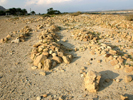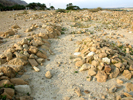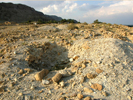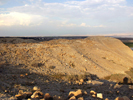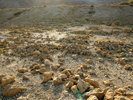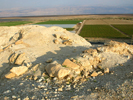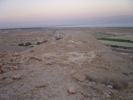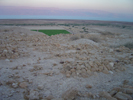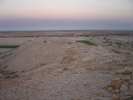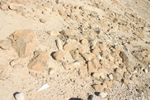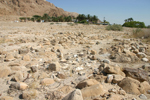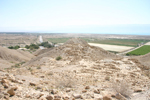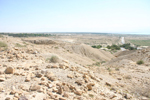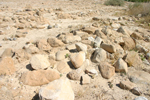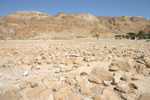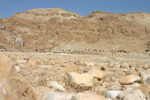Cemetery

Introduction
One main cemetery has been found at Qumran, located 30-40 meters east of the main living area, and two cemetery extensions. It is uncertain whether the two smaller, secondary cemeteries to the south belonged to the sect.
The Qumran cemeteries are one of the least researched aspects of the Dead Sea site, though they began to receive more attention in the 1990’s. Of the more than 1,100 graves discovered, only 63 have been excavated (forty-three by Roland de Vaux; ten by S.H. Steckoll, nine by Magen and Peleg, and one by Clermont-Ganneau,). A re-examination of the main cemetery conducted in 2001 located some graves that had not been spotted previously, using GPR (Ground Penetrating Radar) devices. The survey positively located a total of 1054 tombs, plus an additional 124 potential graves based on GPR data. Of this total, 999 are north-south in orientation and 55 are east-west. The survey also ascertained that an additional 31 tombs had been clandestinely excavated.
The analysis of the data is also complicated by the fact that the cemetery was later used by Muslim Bedouins, and it is not always possible to distinguish between the ancient tombs and these later burials. The following information reflects current observations about the cemeteries at Qumran:
- All tombs are shaft tombs, relatively deep; most contain only a single burial
- Tombs are arranged in neat, ordered rows
- Tombs are separated into three plots via two alleyways
- Tombs have a north-south orientation, with heads facing south, This uniformity in the orientation of the burials is a distinctive characteristic of the Qumran tombs
- The dead lay supine with arms to sides or across pelvis area
- Tombs are marked by a pile of stones along the edge of each grave. They are covered by an oval covering of field stones, occasionally with a larger stone at the head, and sometimes at the foot as well.
- The tombs usually do not have any “grave goods,” though a few contain pottery from the Second Temple period, iron nails, or remains of wooden coffins. Those tombs in the cemetery that contain jewelry appear to have been later Bedouin tombs.
The archaeological team excavated a nearby building that had been found by De Vaux, and identified as a possible “mourning enclosure.” Inside the structure, they found a pile of human bones in secondary burial, which turned out to be the partial remains of two women. Carbon-14 tests done to the teeth revealed that the bones date to the Second Temple period.
They also discovered a zinc coffin. Metal coffins were in use during the Roman and Byzantine periods, but this is an early appearance of zinc—a rare metal that would have been brought from afar.
What can the cemetery contribute to our understanding of the Community of Qumran? The presence of multiple cemeteries located away from what is presumed to be the residency quarters is in keeping with laws pertaining to corpse impurity in ancient Judaism. This would have been especially important to the Community of Qumran in light of their particular stringencies about purity.
Burial Practices in the Scrolls
Only the Temple Scroll (11QT) discusses burial practices. It prohibits mourning practices (such as cutting the body, cutting the hair) which are also prohibited in the Bible (see 11QT 48:8–10, with Lev 19:28 and Deut 14:1). However, the Temple Scroll’s main concern is with purity issues resulting from contact with the dead (see 48:11–14; 49:5–21; and 50:5–9). For instance, 11QT 50:5–9 explains that a person becomes impure via coming into contact with the bones or blood of a dead man or a grave and must immerse himself in water and launder his clothing; until he does this he is a source of impurity for others as well.
Women in the Cemetery?
The most interesting, and debated, aspect of the Qumran cemetery has been the question of the presence or absence of female skeletons. Early analysis of the data from the excavated tombs indicated that only adult males were buried in the main cemetery, but that some women and children had been buried in the cemetery extensions. Later re-examination of the skeletons led to a revision of these conclusions. More importantly, Joe Zias demonstrated, on the basis of the presence of datable jewelry in some of the tombs, that those tombs that were oriented in an east-west direction were late Bedouin tombs. He maintained that none of the female skeletons were from antiquity, but were all more recent burials. More recent studies have moderated this assessment, but even if there is evidence of a few ancient burials of females at the site, it is clear that “the cemetery unequivocally points to a special treatment of women in an otherwise male-oriented community,” as noted by Brian Shultz. He also notes that no ancient remains of children under the age of 16 have been found at the site (earlier researchers had misidentified modern Bedouin burials). Schultz concludes, “These results, when combined with the fact that the Qumran cemetery exemplifies greater uniformity with respect to burial orientation than any other Second Temple period cemetery of its kind, point to its total uniqueness, and fits best with the majority opinion that Qumran was a community center for a predominantly male, Jewish sectarian group in the first century BCE and CE".
More Info
- H. Eshel et al., “New Data on the Cemetery East of Khirbet Qumran,” in DSD 9 (2002), 135-154.
- B. Schultz, “The Qumran Cemetery: 150 Years of Research,” DSD 13, Number 2 (2006) 194-228.
- Susan G. Sheridan, “Scholars, Soldiers, Craftsmen, Elites? Analysis of French Collection of Human Remains from Qumran.” Dead Sea Discoveries 9/2 (2002) 199-248.
- Joseph E. Zias, “Qumran Archaeology: Skeletons with Multiple Personality Disorders and Other Grave Errors.” Revue de Qumran 21/1 (2003) 83-98.
